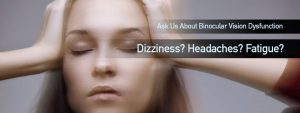Could a sinus headache be caused by a vision problem? Up to 20% of the population suffer from Binocular Visual Dysfunction (BVD).
Binocular vision dysfunction (BVD) is a misalignment of the eyes that can cause pain similar to a sinus headache.
Headaches, dizziness, blurred vision, and reading difficulties can all be caused by anything that hinders our eyes from focusing properly, especially eye muscle strain.
Binocular Vision Dysfunction (BVD)
The extraocular muscles allow you to look up, down, and side to side using your eyes. They respond to brain signals to regulate the eyes, focusing both eyes in the same exact direction.
When the eyes are completely aligned, fusion occurs, allowing both eyes to deliver a single, clear image to the brain.
When the eyes are misaligned, the visual problem binocular vision dysfunction (BVD) occurs.
This misalignment prevents the brain from fusing the two images sent by the eyes into a single, clear image. Double vision or eye strain are common side effects. Vertigo, migraines, and even what appear to be sinus headaches can all be caused by this misalignment of the eyes.
If you suspect you have BVD, schedule an appointment with an eye doctor near you.
SEE RELATED: BVD and Motion Sickness
Vertical Heterophoria
The most common type of BVD is vertical heterophoria (VH), which occurs when the eyes are not aligned vertically.
In some people, one eye may be physically higher than the other. VH patients’ extraocular muscles can get overworked as they try to align their eyes (fusion) and avoid double vision. Over time, the overused muscles get fatigued and stressed, resulting in VH symptoms.
Lightheadedness, blurred vision, headaches, temple pain and dizziness are common complaints among VH patients.
Symptoms of BVD
In addition to dizziness and headaches, patients with BVD may experience:
- Visual symptoms – Shadowed or overlapping vision; sensitivity to glare or light.
- Vestibular symptoms – Nausea, motion sickness, poor depth perception, drifting to one side when walking.
- Pain – Headaches, especially in the area surrounding the eyes, forehead, temples, and sinuses (it feels similar to a sinus headache). You may experience pain when moving your eyes, neck, and upper back.
- Psychological symptoms – Anxiety in high-ceilinged environments, such as shopping malls or big-box stores; feeling frightened or overwhelmed in a crowded environment. These signs and symptoms can be mistaken for agoraphobia or generalized anxiety disorder.
- Reading problems – Reading comprehension issues, losing one’s place while reading, words bouncing around on the page, and difficulties focusing on text. When these symptoms appear in children, they are frequently misdiagnosed as ADD/ADHD.
How to treat BVD
Your eye doctor will perform a neurovisual exam to examine you for mild visual misalignments linked with BVD as part of the treatment for BVD.
Your eye doctor may prescribe prisms to be inserted onto the lenses of your glasses if a misalignment is discovered.
The two pictures received by the eyes are adjusted by prismatic glasses, allowing fusion to occur without overworking the extraocular muscles. Blurred vision, dizziness, headaches, and other symptoms should disappear or be significantly reduced once prismatic glasses are applied.
LEARN MORE: Guide to Binocular Visual Dysfunction (BVD)
Schedule a comprehensive eye exam with an eye doctor near you and kiss your ‘sinus’ headaches goodbye forever.









